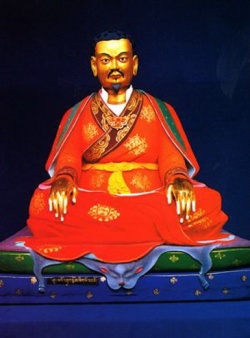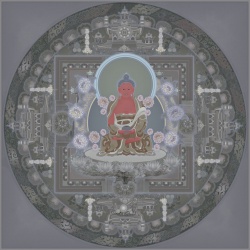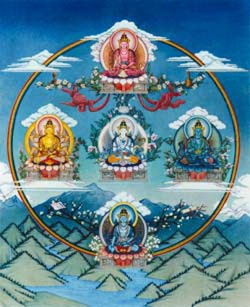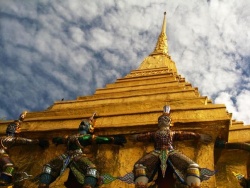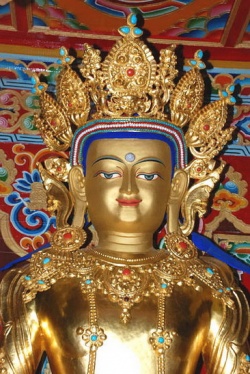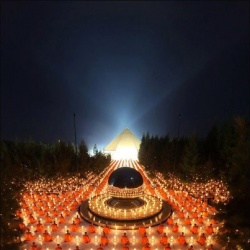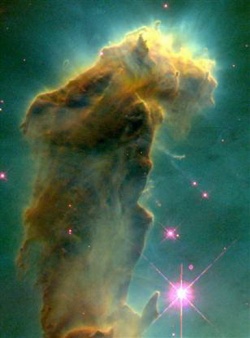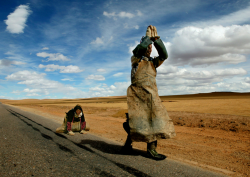Penetrating Wisdom
Penetrating Wisdom: The Aspiration of Samantabhadra
Five Wisdoms
The next section of the Prayer talks about the self-appearing spontaneous wisdom within which, in the case of Samantabhadra, full awakening is manifested. The absolute reality of rigpa, which is the true essence of wisdom, the true fundamental nature of phenomena, arises from this one nature. The spontaneous wisdom of kadak manifests within this one absolute reality.
The unceasing lucidity of awareness
Is five wisdoms of one nature.
When we look at the wisdom of kadak, its essence is shunyata, egolessness. It also has the quality of spontaneous luminosity, which is the primordial clarity that is basic lucidity. This wisdom manifests in the unceasing play of compassion. “The unceasing lucidity of awareness” refers to these three aspects of the wisdom of kadak. In Dzogchen terms, these are called ngowo, rangshin, and tukje. Ngowo is “essence,” rangshin is “nature,” and tukje is “compassion.” That’s a complete understanding of the wisdom of kadak. Ngowo is emptiness, shunyata, egolessness, selflessness. Rangshin is lhündrup ösel, which is spontaneous clarity or basic lucidity. Tukje is the compassion of the kadak wisdom, which is the noble or genuine heart. It is the unceasing manifestation of pure love, pure compassion. The wisdom of alpha-purity is fundamentally free from obscurations. It is the dharmata state, which is the dharmadhatu nature. Appearances freely manifest in that space of dharmadhatu, in the nature of mirrorlike appearances. No matter what appears, no matter in what aspect or in what different clarity it may appear, all appearances are in the same nature of that one wisdom. There’s a sense of equality, of equanimity. That state of wisdom is completely free from any aspect of delusion. In that nature of wisdom, it is free from any aspect of unclarity or fuzziness. It is free from fuzzy logic. The sense of freedom from unclarity is in the nature of total and complete discrimination. Such freedom does not rely on any effort in this fundamental state of wisdom. All actions arise spontaneously. They are accomplished effortlessly in this state of wisdom.
The wisdom of kadak is five wisdoms of one nature. That one nature is alpha-pure. It is the oneness of the three-kaya buddhahood, the oneness of the five-kaya buddhahood, and the oneness of the five wisdoms of the buddha. The one nature of the five wisdoms is described as the sun and the sunlight, or the moon and the moonlight. They are in one nature yet they are different.
The wisdom of buddhahood, the wisdom of enlightenment that is the fully matured aspect of rigpa, manifests as these five wisdoms. The five wisdoms are the dharmadhatu wisdom; the mirrorlike wisdom; the wisdom of equality; the wisdom of discriminating; and the wisdom of accomplishment.
Dharmadhatu wisdom is the basic state of being completely pure. Dharma is “phenomena.” Dhatu is the “essence” or “truth,” “the nature.” So dharmadhatu means the true essence of phenomena. Dharmadhatu wisdom is the wisdom of seeing the true nature of phenomena. That true nature of phenomena has never been born. Phenomena, from the beginning, have never arisen as confusion. These confusions, the solidity of the phenomenal world, have never existed in the middle because they have never arisen. Because they have neither arisen in the beginning nor existed in the middle, there is no cessation of that confusion. It’s pretty simple. The emotional disturbances of samsaric phenomena have no cessation. There is no cessation of that ego-clinging. There is no cessation of our self-centricity. There is no end because it never existed to begin with. It has never been given birth to. The wisdom of seeing that true nature of phenomena is what we call dharmadhatu wisdom. This is the first wisdom of buddha.
The unimpeded nature of this clarity manifests like images in a mirror. That is the second wisdom, called “mirrorlike wisdom.” The mirrorlike wisdom of buddha has the quality of egolessness because it is free from ego-identification. This wisdom is beyond conceptual seeing and beyond conceptual understanding. Therefore, it is taught with the example of a mirror.
If we place ourselves in front of a big mirror, everything appears instantaneously. It doesn’t happen that first one row of images arises, then a second row, then a third row, and so on. At the same time, a mirror does not identify each thing that reflects in it. It does not say, “Okay, now the trees are reflecting. Now the carpet is reflecting. Now the people are reflecting. These are such and such people. This is such and such color of reflection.” There is no such egotism in that wisdom nature. In a mirror, everything reflects simultaneously. Therefore, this is called “mirrorlike wisdom.” In a similar way, for a buddha, the phenomena of the three times reflect simultaneously. Everything arises simultaneously. There is neither a progression of seeing nor a progression of conceptualization. A buddha sees the three times in one instant. That is the example of mirrorlike wisdom.
As we discussed, in whatever variety they may appear, appearances are in the same nature. That’s the third wisdom, called “the wisdom of equality or equanimity.” This refers to the wisdom of selflessness. Selflessness leads us to the ultimate realization of equanimity. Equanimity here refers to the equality of duality. It means there is no longer any difference between the self of phenomena and the self of person. The distinction of duality as perceiver and perceived is no longer made at this point.
Therefore, the wisdom of buddha sees the true nature of this equal state. Whether you are looking at the phenomenal world outside, such as a table, a house, mountains, and so forth, or at your own self as a person, they are equally selfless. Both rest in the same nature of equality that is emptiness, shunyata. The realization that is the ultimate seeing of that selfless nature is what we call the wisdom of equality.
The wisdom of equality arises in the bodhisattva path from the practice of exchanging oneself for others. We try to see the suffering of others, and we try to take the pain from others. We try to transcend our self-clinging through taking on the self-clinging of others. As a result, you get this wisdom called “the wisdom of equanimity.” The fourth wisdom is the wisdom of discrimination, which is completely free from delusion. It is a sense of sharpness and precision. Discriminating wisdom refers to a buddha’s wisdom of seeing relative reality. Mirrorlike wisdom is the basic clarity that reflects in the mirror while discriminating wisdom sees the distinctive features and qualities individually. It is the wisdom of seeing appearances, of seeing how things exist. For example, it is the wisdom to discriminate the nature of the outer phenomena as being impermanent and the nature of phenomena as being emptiness. It is the wisdom to discriminate the nature of things existing in different levels of confusion in the samsaric realm. That wisdom is called “the wisdom of discrimination.”
There is an example of how buddhas see this. If one of us falls asleep and has a nightmare, or has some painful illusion in a dream, a person with clairvoyance can see that. He can see that sleeping person going through tremendous pain for no reason. That person is experiencing a lot of fear in the dream. Maybe that person is being chased by a poisonous snake or a tiger. In that dream, he has objects of fear and he has a subject who fears. He is running through that illusion of pain.
For the person who is clairvoyant, none of this exists. The person who sees is not going through the suffering. He can see that the sleeping person is simply dreaming. The clairvoyant person knows that if this person awakens from the dream, then he will be totally free from that illusion of fear. So the clairvoyant person may try to wake this person up by using a particular method, perhaps by speaking a little bit louder. Such seeing by a clairvoyant person is what we call “the discriminating wisdom of a buddha.” All of these wisdoms arising naturally, spontaneously, and effortlessly is the fifth wisdom, called “the all-accomplishing wisdom.” The all-accomplishing wisdom refers to the manifestations of a buddha’s activities. This wisdom, manifesting in such outstanding ways, can be so beneficial to wake people up from the dream. The wisdom Excerpts from ‘Penetrating Wisdom:
of knowing the best method to awaken beings from the nightmare of samsara is called “the all-accomplishing wisdom.”
Accomplishing all the relative and ultimately-beneficial things for all sentient beings is what we call “all-accomplishing wisdom.” Therefore, buddha sometimes uses the bucket of water method to wake someone up. If you use a bucket of water, sometimes the sleeping person might die from the shock, or perhaps have a heart attack. In those circumstances, buddha wouldn’t use a bucket of water, but would instead simply present an alarm clock to this person. The different methods of accomplishing enlightenment are called “the all-accomplishing wisdom.”
These are the five wisdoms in one, as it is taught. This explanation is not from my firsthand experience. It is from my first-hand conceptual understanding of the five wisdoms of a buddha.
Buddha Families
The Prayer continues with the further manifestation of the five wisdoms of the alphapure nature:
Through the ripening of the five wisdoms
The five families of the first buddha arose.
In other words, from these five wisdoms we get the principles of the five buddha families. This doesn’t necessarily mean five separate beings. We are talking about the five different elements of the wisdom of buddha, such as dharmadhatu wisdom and so forth. The five Buddha families also arise from the five poisons of mind. According to Tantra, this is because the essence of our five poisons of mind is in the essence of the five buddha families. It is pretty amazing, pretty inconceivable.
When we look at these five wisdoms of a buddha, they are actually the nature of the five poisons. The essence of ignorance, the true nature of ignorance, exists in the nature of dharmadhatu wisdom. The wisdom of dharmadhatu is the absolute nature of the poison of ignorance. It exists, or arises, in the nature of Vairochana Buddha, the buddha in the center of the five buddha families. Vairochana is of that family called the Buddha family. Vairochana is the embodiment of the body essence of the buddhas. In the ordinary state, that wisdom is the nature of the skandha of form.
Mirrorlike wisdom is the absolute nature of the poison of aggression and hatred. That wisdom, as well as that poison, is in the nature of Akshobhya Buddha, the buddha of the eastern direction. Whenever aggression arises, it is the manifestation of Akshobhya. The mirrorlike wisdom manifests in the form of aggression when we are confused. Akshobhya Buddha belongs to the Vajra family and is the embodiment of the mind essence of the buddhas. In terms of the skandhas, it is the skandha of feeling. In a similar way, the wisdom of equanimity is the absolute nature of the poison of pride. The transcendent nature of pride, that essence or fundamental state of pride, exists in the nature of Ratnasambhava. Ratnasambhava, the buddha of the southern direction, is in the nature of the wisdom of equality. Ratnasambhava Buddha is the manifestation arising from the transcendent nature of pride. The qualities of all the buddhas are embodied in one manifestation, Ratnasambhava. In terms of the skandhas, it is the skandha of perception and it belongs to the Ratna family, obviously.
The wisdom of discriminating awareness is the absolute nature of passion. The essence of our desire is in the nature of Amitabha Buddha, the buddha of the western direction. Amitabha Buddha manifests from the transcendent quality of passion. That nature of Amitabha Buddha manifests in discriminating wisdom.The manifestation of all the buddhas’ speech is embodied in Amitabha. It is the skandha of formation, and belongs to the Padma family.
The all-accomplishing wisdom is the absolute nature of the poison of jealousy. It manifests in the northern direction and is called Amoghasiddhi Buddha. The all accomplishing wisdom of buddha is the result of the transcendent nature of our poisonous emotion of jealousy. In the Vajrayana sense, the genuine essence of jealousy is the nature of Amoghasiddhi Buddha. Amoghasiddhi Buddha is the embodiment of all the activities of buddha. Therefore, this buddha family is called the Karma family. Karma means “action” or “activity.” It is the skandha of consciousness.
When we look at this progression of how the wisdom of rigpa manifests in Tantra, we can clearly see that everything arises from rigpa. There is only one rigpa, one origin, one basis. It is the true nature of our mind. It manifests outside in these five different aspects in which everything is included. No matter what outer and inner appearances we experience, they all exist in the sphere of the five buddha family wisdoms that boil down to one essence. That condensed essence is rigpa.
The Dzogchen tantras are the basis of such presentations of the five buddha families. They are presented in detail in the teachings of the Dzogchen lineage, especially by Padmasambhava.
Five Poisons
Through the gradual intensification of habit
Sequential entry into samsara began.
The five poisonous kles´as developed.
The actions of the five poisons are unceasing.
Gradually we intensify, gradually we solidify, and gradually we develop deeper impressions of this pattern of duality. This pattern repeats over and over and over. It becomes so solid and appears so genuine that it almost becomes part of us. It almost becomes the nature of our mind.
Whenever we think of mind, we are thinking about “I.” That’s duality. In gradual steps, we get deeper and deeper into this samsaric pattern. From that fundamental ignorance and the development of the split of duality, the actions of the five poisons increase. This develops into a stream of endlessly repetitive actions of the five poisons. We get into that mechanism of habitual pattern. Then we enter into samsara in a deeper sense, no matter what level of samsara we may be experiencing.
Once we have developed that degree of intensification or habituation, the mechanism doesn’t stop. It continues to run automatically. The example we use in Buddhism is a potter’s wheel. Some kind of effort is required for the potter to start turning the wheel. Once the wheel is turning, it doesn’t stop. It just keeps going on and on and on, continuously. You actually have a hard time stopping it. Similarly, once we have turned the wheel of the five poisons, it doesn’t stop. It’s unceasing. Do you remember any break from the five poisons? It’s very difficult. I don’t quite remember having any break from the five poisons.
From this endless stream that we call karma, the samsaric solidity of suffering, of ego clinging, and of poisonous emotions gradually develops. When that has developed, we end up in this solid existence of samsara. The progression that ends up as the existence of samsara is basically the twelve nidanas, the twelve links of interdependent origination. Beginning with ignorance, formation, and so forth, we have the inner cycle of twelve interdependent nidanas. We also have these twelve links in the outer sense: the twelve astrological cycles called the twelve months, the cycle of twelve years, and so on. From the repetition of the twelve interdependent originations, we solidify our habitual inclinations and tendencies. In that way, we solidify our samsara. We have the habitual tendency to delude our perception. We delude our conception, our view, and our understanding. As a result of habitual tendencies, we are always caught up in this cyclic existence called samsara. We get caught in the continual cycle of the five poisons. The unbroken continuity of habitual tendency, the unbroken continuity of the five poisons, is the existence of samsara. It is the only reason we are bound to this suffering. It is the only reason we are caught up in this suffering. We learn here that samsara is nothing apart from our habitual delusion.
According to Dzogchen, the five poisons are nothing but the manifestation of the luminosity of rigpa. They are called ö nga, the five luminous lights. The five luminous lights of rigpa are white, yellow, red, green, and, like the color of Kuntuzangpo, deep blue. Each of the five lights has meaning. The luminous white light of wisdom is the manifestation of rigpa’s immaculate nature. That completely pure nature, that completely pacified nature, manifests as the white luminous light. The yellow luminous light is the manifestation of rigpa’s fully completed qualities. This means that rigpa is fully enriched with all the qualities of buddha. Rigpa is fully equipped, so to speak, with all the enlightened wisdoms necessary to overcome our emotions and ego clinging. That completeness of qualities manifests as yellow light, which is richness.
The red luminous light is the manifestation of the quality of rigpa that encompasses and magnetizes. Like a magnet, it draws all things in that direction. In a similar way, that very nature of our mind called rigpa encompasses all qualities, encompasses all wisdom. This means that everything is included within rigpa, nothing is left outside. That’s why we have this magnetizing red light, which encompasses all the qualities. The difference between the yellow and the red light is that the yellow light of enriching has the quality of possessing all the many different elements of buddha wisdom, while the red light of magnetizing encompasses all these qualities that actually boil down to rigpa. It’s rigpa that has all these qualities. So everything boils down to one and only one essence. The single essence, which that contains all, is rigpa. It is the primordial mind, the primordial wisdom.
The luminous green light means that rigpa manifests all the activities of buddha. Rigpa has the compassion, love, and wisdom that buddhas manifest as physical activity, verbal activity, and samadhi, meditative absorption. All of these activities of buddha are complete within rigpa. Symbolizing that is the luminous green appearance of light, which is the fourth light taught in Dzogchen.
The fifth light is the deep luminous blue light that symbolizes the unchanging nature of rigpa . No matter what confusions we may experience at this point, the true state of rigpa is beyond all confusion. No confusion, ego-clinging, or mind poison can ever touch the true state of rigpa. They can never cause it to change. The absolute state of our mind is in the unchanging nature of rigpa, the unchanging nature of the buddha wisdom. Therefore, we have this luminous blue light.
The five elements manifest from these five lights. The water element manifests from white light. The earth element manifests from yellow light. The fire element manifests from red light. The wind element manifests from green light, and the space element manifests from blue light. These are the five elements.
From these five lights, the five objects of the five poisons also manifest. When we fail to recognize the five-colored luminosity of rigpa manifesting, we misperceive it. We misperceive the luminous white light of rigpa as ignorance. We misperceive the luminous yellow light as pride. We misperceive the luminous red light as passion, desire, and attachment. We misperceive the luminous green light as jealousy, and we misperceive the luminous blue light as aggression. We misperceive these five luminous lights as the five poisons.
According to Dzogchen teachings, the five luminous lights can be the objects of the five poisons as well as the five poisons themselves. If you take them as the objects of the five poisons, then they correspond with the emotions as we have said. As the subjects of the five poisons, they are the five buddha families. Within the five buddha families, ignorance is Vairochana; aggression is Akshobhya; pride is Ratnasambhava; passion is Amitabha; and jealousy is Amoghasiddhi.
Since they do exist in that nature, the Prayer says that samsara begins as a result of the failure to recognize the true nature of the five poisons and their objects. Whenever these appearances of lights arise, these appearances of the five poisons, we can recognize them in their true nature as the five buddha families. We can recognize them in the nature of the five buddha wisdoms. If we recognize them, it becomes liberation. Therefore, Samantabhadra makes this aspiration, saying,
Therefore, since the ground of the confusion of beings Is mindless ignorance,
Through the aspiration of myself, the buddha,
May all recognize awareness.
We have these five emotions within the five wisdoms. This is taught in Vajrayana Buddhism in general and Dzogchen in particular. Whenever we have ignorance, it is in the nature of dharmadhatu wisdom. When we have aggression or irritation, that exists in the nature of mirrorlike wisdom. When we have pride, that nature of mind exists in the wisdom of equanimity. When we have passion, desire, or attachment, that mind exists in the nature of discriminating wisdom. When we have jealousy or envy, it exists in the nature of all-accomplishing wisdom. Therefore, these five poisons remain in the five wisdoms of buddha.
It is important to identify the emotion in which we are engaged, even though it is often mixed. Passion, aggression, jealousy, and so on are all mixed at certain points. Identifying them is the process that naturally takes us to mindfulness, to awareness. There is no other way.
When we recognize an emotion, such as strong passion accompanied by jealousy, we are actually breaking down the speed of that emotion. The total sense of recognition is quite important in both Sutra and Tantra. In Sutra, it is mindfulness. In Tantra, if we see that nature and look at it nakedly, we will see the nature of that wisdom. You don’t need to logically apply any reasoning. You don’t need to conceptually meditate on anything. Just simply recognize and observe it. Whether it is dharmadhatu wisdom, mirrorlike wisdom, or any of the other five wisdoms, you will see the nature of that wisdom. We will have the experience of that wisdom by simply being with it without conception. Therefore, recognition is quite important.
The first step is just simply to observe it. Simply recognize the emotion and then watch it as it grows or as it continues. Just simply watch it. In the beginning, just to have an idea that it’s coming is very important and very effective. In the Vajrayana sense, the way to watch these emotions is without stopping them. If we recognize the emotion and say, “Yes, it is passion,” and then try to stop it, that’s a problem. Rejecting our emotions is a problem in Vajrayana.
Instead of trying to stop it, let it come. Invite it more. Look at the nature of passion more nakedly. Look at the nature of aggression, look at the nature of ignorance, look at the nature of anything. Once we have received the pointing-out instruction from our vajra master, we know how to watch it. We know how to look at it. We don’t have to leave something behind and go to a certain place called “liberation.” That simple process of looking at it in every moment actually brings liberation on the spot. Within that nature of passion is liberation, within that nature of aggression is liberation. If we know how to watch in that state, then we find the liberation within that passion.
In the shamatha-vipashyana of Mahamudra practice, there are the shamatha methods of calming the emotions and the vipashyana methods of watching our emotions. In the Dzogchen tradition, there are the methods of Trekchö to cut through the emotions and the methods of Thögal to experience the luminosity of the emotion, of those states of mind. These things are details that we need to have pointed out. Therefore, we’re making the aspiration for all beings to recognize their awareness because awareness is the primary nature of our minds. Lacking the recognition of awareness, we get into the delusion of ignorance and the whole wheel of samsara. This is the view of Dzogchen. It’s simple, right?
When we make this aspiration prayer of Samantabhadra, we do so remembering the nature of our five poisons.We do so remembering the samsaric chain in which we are caught and the process of samsaric existence. We do so remembering the true nature of rigpa, the five wisdoms, and the five families of Buddha Samantabhadra. We make this aspiration saying,
May all recognize their own radiant awareness.
Samantabhadra makes this prayer in order that all beings be free from the delusion of samsara and from the cause of that delusion. The cause of that delusion is unawareness, unmindfulness. Our aspiration is that all sentient beings recognize this true nature that we are beginning to discover, that we are beginning to familiarize ourselves with. May they be free from unmindfulness and achieve the wisdom to recognize their own radiant awareness.



